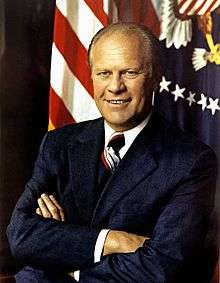Thomas S. Kleppe
| Thomas Kleppe | |
|---|---|
 | |
| United States Secretary of the Interior | |
|
In office October 17, 1975 – January 20, 1977 | |
| President | Gerald Ford |
| Preceded by | Stanley K. Hathaway |
| Succeeded by | Cecil D. Andrus |
| Administrator of the Small Business Administration | |
|
In office January 18, 1971 – October 12, 1975 | |
| President |
Richard Nixon Gerald Ford |
| Preceded by | Hilary J. Sandoval Jr. |
| Succeeded by | Mitchell P. Kobelinski |
| Member of the U.S. House of Representatives from North Dakota's 2nd district | |
|
In office January 3, 1967 – January 3, 1971 | |
| Preceded by | Rolland W. Redlin |
| Succeeded by | Arthur A. Link |
| Mayor of Bismarck | |
|
In office April 1950 – April 1954 | |
| Preceded by | Amil Lenhart |
| Succeeded by | Evan Lips |
| Personal details | |
| Born |
July 1, 1919 Kintyre, North Dakota, U.S. |
| Died |
March 2, 2007 (aged 87) Bethesda, Maryland, U.S. |
| Resting place | Arlington National Cemetery |
| Political party | Republican |
| Spouse(s) | Glen Loew Gompf |
| Children | 4 |
| Education | Valley City State University (BA) |
| Military service | |
| Allegiance |
|
| Service/branch |
|
| Years of service | 1942–1946 |
| Battles/wars | World War II |
Thomas Savig Kleppe (July 1, 1919 – March 2, 2007) was an American politician who served as the Representative from North Dakota. He was also the Administrator of the Small Business Administration and the U.S. Secretary of the Interior.[1][2]
Early life and military service
Kleppe was born on July 1, 1919, in Kintyre, North Dakota, the son of Lars O. Kleppe and his wife Hannah Savig Kleppe. He graduated from Valley City High School in Valley City, North Dakota in 1936. Kleppe graduated from Valley City State University, (then Valley City Teachers College). During World War II, Kleppe served from 1942 to 1946 as a Warrant Officer. [3]
Career
From 1950 to 1954, Kleppe was the Mayor of Bismarck, North Dakota. From 1946 to 1964, he was the president and treasurer of the Gold Seal Company. In 1964, Kleppe was the Republican nominee for United States Senate but lost to the popular incumbent Democrat Quentin N. Burdick. In 1966 he was elected to the Ninetieth United States Congress, and he was reelected in 1968 to the Ninety-first United States Congress (January 3, 1967 – January 3, 1971). In 1970 he was again an unsuccessful candidate for election to the Senate, losing a rematch to Burdick by a wide margin. [4]
He served as the Administrator of the Small Business Administration, and later served as the Secretary of the Interior for President Gerald Ford. In his capacity as the Secretary of the Interior, Kleppe was the appellant in Kleppe v. New Mexico (1976), when the Supreme Court ruled that Congress has the "power to protect wildlife on the public lands, state law notwithstanding."
Personal life
His first wife, Frieda K. Kleppe, died in 1957. Kleppe married his second wife, Glendora Loew Gompf, on December 18, 1958. He had two children from his first marriage and two daughters from his second marriage. He resided in Bismarck, North Dakota. Kleppe died of Alzheimer's disease, in Bethesda, Maryland, on March 2, 2007. He was buried in Arlington National Cemetery in Arlington, Virginia. [5]
See also
References
- ↑ Thomas Savig Kleppe (Scandinavian-American Hall of Fame)
- ↑ "Thomas Kleppe" (PDF). Homestead National Monument of America. Retrieved January 1, 2016.
- ↑ John Robert Greene (January 6, 2016). "Thomas S. Kleppe (1975–1977) - Secretary of the Interior". Miller Center of Public Affairs, University of Virginia. Retrieved January 1, 2016.
- ↑ "Gold Seal Company". bismarckcafe. Retrieved January 1, 2016.
- ↑ Virginia Grantier (March 5, 2007). "Former Rep. Tom Kleppe dies". Bismarck (ND) Tribune. Retrieved January 1, 2016.
Other sources
- United States Congress. "Thomas S. Kleppe (id: K000264)". Biographical Directory of the United States Congress.
External links
| U.S. House of Representatives | ||
|---|---|---|
| Preceded by Rolland W. Redlin |
Member of the U.S. House of Representatives from North Dakota's 2nd congressional district 1967–1971 |
Succeeded by Arthur A. Link |
| Political offices | ||
| Preceded by Hilary J. Sandoval Jr. |
Administrator of the Small Business Administration 1971–1975 |
Succeeded by Mitchell P. Kobelinski |
| Preceded by Stanley K. Hathaway |
United States Secretary of the Interior 1975–1977 |
Succeeded by Cecil D. Andrus |




